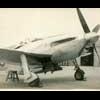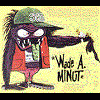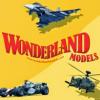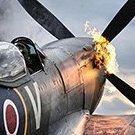Search the Community
Showing results for tags 'hawker'.
-
Hi all. Here is my third and last "Corona-Modell" as I´m back at work since last week.😁 It´s the "Expert Set" edition of the very nice Arma Hobby kit in 1/72 scale. Only weak points are the guns and exhausts. I choosed the all black BE500 LK - A, flown by 87th Sqn. Ldr. Denis G. Smallwood. Daniel
- 17 replies
-
- 43
-

-

-
- Hawker
- Nightfighter
-
(and 1 more)
Tagged with:
-
Well for my quarterly (or so) photo session I pulled out a bunch of completed kits finished this year. I've just posted a couple of them on another forum and was working out the ones appropriate for Britmodeller when in a case of Serendipity I realised the title for he FW190's in the other post applied just as equally to 2 of the subjects with a British theme. The 1st is a RAAF tropical trials Typhoon. It is a Brengun kit and represents 1 of 3 aircraft sent to the Middle East to test out a Tropical filter. They were operated by 451 Squadron RAAF and the kit has been modified by a conversion set made by Red Roo. This consists of a tropical filter in resin and decals for all 3 Tropical airframes. The main issue with the kit is a number of panel lines having mould damage which need rescribing. I also had trouble with the wing to fuselage fit and the canopy. The latter has been replaced by a Falcon vacform. The fishplates on the fuselage come from a Brengun etch set.
-
See post 8 😳: https://www.britmodeller.com/forums/index.php?/topic/235068063-172-hawker-nimrod-by-ibg-models-release-in-2020/&tab=comments#comment-3584921 Among the secret items from the IBG Models catalog 2020 (link) there might be a 1/72nd Hawker Nimrod kit. Source: The RVB Cocardes Nurnberg Toy Fair 2020 report link V.P.
- 9 replies
-
- 5
-

-

-

-
- Nimrod
- IBG Models
-
(and 1 more)
Tagged with:
-
Tempest Fuselage Fuel & Oil Tanks (4394) 1:48 CMK by Special Hobby We reviewed the resin upper engine set from CMK here, and at the time I hadn't noticed that I also had this set to review too, so aren't I silly? This set arrives in a yellow-themed shallow blister pack with header card and instructions within, and 12 resin parts on six casting blocks within. The kit’s fuselage halves will need to be cut to expose the area, which is covered in diagrammatic form in step one, and while you’re cutting you might as well expose the engine, eh? The oil tank is first to be made up with a small part added to the flat underside, and then two supports are fixed to the sides of the larger fuel tank with its filler caps on the top. These are integrated into the aircraft either side of the cockpit’s front firewall, with the smaller tank resting on the kit’s cockpit sidewalls behind the instrument panel. Forward of the firewall the fuel tank is added, and it is completed by threading the resin hoses through from one side to the other, linking the two area. The fuselage panels you cut out are discarded and replaced with the new resin part that is well detailed and at a more scale thickness than the styrene you remove. On its own or coupled with the engine set it will look superb once installed and painted, giving plenty of scope for a maintenance/repair diorama. Highly recommended. Review sample courtesy of
-
- 1
-

-
- CMR
- Special Hobby
-
(and 1 more)
Tagged with:
-
Hi! So, I decided! The status of this kit can be seen in the photo in this my posting: Firstly, I have only "nude" mold without box, instructions & decal. With decal we will invent something! I am very grateful @PeterB for trying to help: but I'm afraid he will not be able to help me....as I think. About this model. I know its disadvantages: Naturally I will not correct these shortcomings. But something I still decided to do: What do I think to do next? Probably something must be done with the cockpit interior and nose radiator interior.... after then glue and painting... B.R. Serge
- 58 replies
-
- 4
-

-
- Hawker
- Typhoon car door
-
(and 1 more)
Tagged with:
-
Quick question for the experten here. Im looking at possibly doing a plane for the RAF 100 Anniversary group build coming up in April. Im debating one of three options ? Im normally a WW2/Coldwar builder but im thinking of expanding into 1930’s types. For the build i was thinking either Bristol bulldog ? Hawker Fury ? Or if i stay WW2 an eagle squadron from the early years. I know there are airfix furies and bulldogs would these be good options to start with a 1930’s bi-plane ? Dennis
-
Now a little thematic from the Yugoslav territories. The model is old, but I was satisfied with the final result. Here are the pictures, enjoy.
- 3 replies
-
- 11
-

-
- Hawker
- Hawker Hurricane
-
(and 1 more)
Tagged with:
-
Hello, I am building the Airfix Typhoon. I have a query about the upper wing roundels. The decals scale out to match a 50 inch size roundel. To me this looks too big and it overlaps the edge of the leading edge wing lamp. Wikipedia indicates a 42 inch roundel was used as an exception to the standard on the Typhoon up to January 1945, and then all 2nd TAF aircraft were changed as detailed below: “Type A.1: FromJune 1940: Single and twin engine fighters, light and medium bombers 35 inches. Exceptions: Hawker Typhoon 42 inches, Westland Whirlwind 28 inches. Heavy bombers, transport aircraft 49 inches.” However the same article also says “January 1945 to June 1947: On all 2nd TAF aircraft, Type B upper wing roundels were either converted to 55 inches (140 cm) type C1 roundels or over-painted and 36 inches (91 cm) type C1 roundels painted on. “ https://en.m.wikipedia.org/wiki/Royal_Air_Force_roundels A 55” roundel would be even bigger than the decals supplied in the kit! 58mm in 24th scale. My guess is that the 36 roundel might actually be the best bet, but there seems to be some confusing information out there. That scales out at 38mm in 24th scale. Much smaller than the 53mm kit version. Both card door and bubble kits have the same size decals. This size is repeated in the Eagle Cal decal sets too. Nowhere can I see info which says that a Typhoon carried a standard 50 inch roundel. Surely they can’t all be wrong?
-
After the Hurricane, Airfix is to release in Q2 2017 a 1/48th Hawker Sea Hurricane Mk.1B - ref. A05134 Source: http://www.airfix.com/uk-en/shop/new-for-2017/hawker-sea-hurricane-mk-ib-1-48.html V.P.
-
AZmodel is to re-release its 1/72nd Hawker Hart B.4 kit - ref. AZ7619 Sources: http://www.azmodel.cz/2019/06/hawker-hart-b-4/ https://www.facebook.com/azmodelkits/posts/2474298142594780 V.P.
-
RP-3 60lb Rockets & Bronze Undercarriage Legs for Tempest V (648450 & 648446 for Eduard) 1:48 Eduard Brassin We've only just got over the excitement of this marvellous new tooling from Eduard, and along come some extras that will improve your model further. Eduard As usual with Eduard's resin sets, they arrive in the familiar Brassin rectangular or clamshell box, with the parts safely cocooned on dark grey foam inserts, and the instructions inside to complete the package. RP-3 60lb Rockets for Tempest V (648450) This set rocks up in a cardboard box, and contains eight resin rocket bodies with moulded-in fins, eight launch rails, a sheet of Photo-Etch (PE) brass and a small decal sheet. The rockets need their exhausts drilling out with a 1mm bit, and are then decked out with numerous PE fittings that facilitate their attachment to the rails later on. The rails are handed, so take care when installing them, then glue the rockets in place and attach the launch command wire to the back of the rocket and the rear of the pylon. Strangely, Eduard show the tails hanging down from the wing in their diagram, which is only the case when they are fitted to the rails but aren't yet plugged into a socket on the back of them. Remember this though, and you'll be fine. As usual the paint codes are in Gunze shades, and the decals are also shown in place on the same diagram. Tempest V Undercarriage Legs BRONZE (648446) This set is in a clamshell, and includes six resin bay door parts and two handed gear legs that will allow you to replace the kit's plastic gear legs with more robust bronze ones with super-crisp detail. Everything proceeds as per the kit until completion, when you attach a small 0.5mm diameter wire to the rear of each leg. You'll need to supply the wire yourself, but they give you the length at 4.5mm, and a scrap diagram to ensure correct orientation. Again, the colour codes are in Gunze shades, and are called out during construction instead of separately due to the manner of construction. Review sample courtesy of
-
Here's some shots of the sprues for the brand new 1/72 Hawker Typhoon Mk.Ib from Airfix, you can tell they've put a lot of thought into the construction of the kit. http://www.wonderlandmodels.com/products/airfix-172-hawker-typhoon-mkib/
- 212 replies
-
- 2
-

-
This is an FGA.9 pics from Graham James
-
Tempest Mk.V ProfiPACK (82121) 1:48 Eduard The Tempest was a development of the Typhoon, and might account for my endless ability to get their names confused. Originally called the Typhoon II, it was envisioned to solve any and all of the issues that bothered its designer Sidney Camm. The main difference was a much thinner wing which reduced drag and improved aerodynamics of the laminar airflow. The wings could accommodate 20mm Hispano cannons that packed an enormous punch, and lent itself to the low-level attack role that it was designed for. The engines intended to power the aircraft were the Centaurus, Griffon and Sabre IV, and initially the Rollf-Royce Vulture, which was terminated early in the design phase, leaving the three options going forward and necessitating substantially different cowlings to accommodate their differing shapes. The Mark V was split into two series, with the Series 1 having the Sabre II that had a similar chin intake to the Typhoon and many Typhoon parts, while the later Series 2 used fewer Typhoon parts and had their cannon barrels shortened so they fitted flush with the leading edge on the Series 2s. A few of the early Mk.Vs were used as test beds, while other marks were developed alongside it, such as the Mk.IIs with Centaurus engines and a cylindrical cowl; Mk.VIs which had a very short production run; the Mk.III and Mk.IV that used a two types of Griffon engine and didn't see service, and later the TT.Mk.5, which is where a lot of Mk.Vs ended their days towing targets in garish colour schemes. The Kit This is a complete 100% new tool, and shouldn't be confused with their older Tempest V that's been around for ages, and has some known issues with its tail. It arrives in the standard ProfiPACK box, with a brand new painting on the front showing the Tempest upsetting a V1 "Doodlebug" flying bomb, which was one of their tasks due to their speed and ruggedness, with stories of tipping them with a wingtip, and blowing them up from way too close with cannon fire. Either way it's extreme bravery on the part of the pilots that helped to reduce the toll on London from these new "vengeance" weapons late in the war. Following on the heels of their recent Spitfire, 109 and 190 toolings, the Tempest is packed with surface detail that is at the leading edge of moulding technology and skill. The rear of the fuselage is festooned with raised rivets that are correct for this series, and there are differing width panel lines, a number of types of fastener, with the detail extended across the whole airframe. The interior is similarly well detailed with pre-painted PE instrument panel and seatbelts amongst other parts, which you can upgrade further by purchasing the Brassin set that's available separately. Inside the box are five sprues of dark grey styrene, a circular sprue of clear parts, a sheet of pre-painted and nickel-plated Photo-Etch (PE), a set of canopy masks in yellow kabuki tape (not pictured), and the instructions with the profiles printed in colour in the rear of the booklet. Construction begins in the cockpit, which has a solid floor and framework sides, exposing the interior of the fuselage behind, which has been detailed by the designers inside the fuselage halves, showing great attention to detail. The seat, control column and rudder pedals are fitted to the solid areas, while the instrument panel and side consoles are suspended from the framework sides, which fit between the front and rear bulkheads, the latter being armoured and supporting the seat with a small framework of parts. The pre-painted belts are attached to the seat before installation, and more PE is used in the side consoles, resulting in a very neat and well-detailed cockpit. Before the fuselage can be closed around it, the interior area needs to be painted black (I prefer dark grey with a black wash), the simple tail-wheel bay needs constructing, and the complex radiator intake is built up from a substantial number of parts, which are shown with the correct order noted for your ease. You may want to pre-prepare some of the sub-assemblies in case there are any seams to fill in the intake trunking here. The final parts for the cockpit interior are fitted to the fuselage sides at this point, so that they show through the framework once it is installed. The lower wing is a single full-span part, and as you would expect the upper wings are separate parts that have the landing gear bay roof detail moulded in. The sides of the bays are added along with some detail parts in both bays, at which point the wings can be closed up and the whole assembly joined with the fuselage, and once the tail feathers with their separate rudder and elevators are fitted, that's the airframe ostensibly complete. The cockpit aperture is over-large, which allows an insert to be dropped in after it is fitted out with detail parts specific to this variant, the elevators and cannon barrel inserts are added to the wings, and it's then time to build and fit the landing gear. The tail wheel has a two part strut with Y-shaped yoke and separate two-part wheel that has an anti-shimmy groove moulded in, and two bay doors plus actuator for when the leg is retracted in flight. The main gear wheels have a large two-part balloon tyre with the Dunlop brand in raised letters on the side, and separate hubs for both sides to obtain the most detail. There is no tread, so hiding the seam on the tyre's contact patch will be easy, and if you like your wheels weighted, just sand a flat spot at the bottom. The gear legs are a single part each, and have a complex single-part retraction jack that extends inboard into the bay, with large captive bay covers on the leg, and smaller inner doors that fold toward each other on the centreline. A drop-down stirrup is fixed to the underside of the fuselage for the pilot, a pitot probe added to the wing, and a bunch of PE fish-plates are added to the transport joint at the rear of the fuselage, which were to correct a structural weakness in these early airframes that utilised some of the Typhoon parts. On the topside the two-part canopy is attached, with the opener having a styrene insert for added detail that latches into the track, with a whip-antenna just behind its furthest point when open. The four-bladed prop is a single part that is attached to the back-plate and spinner cap, then glued to the front of the fuselage along with a pair of exhaust stubs, which don't have hollow tips. There is a resin set that adds more detail and includes hollow tips that we'll be reviewing later, once we've finished drooling over this. The canopy masks also include a pair of dots for the tail wheel, and tread-plate masks for the root of each wing that will be useful to cover up an initial squirt of black before you begin painting the main colours. There aren't any weapons shown in the instructions, but they are available on the sprues in the shape of eight unguided rockets with moulded-in rails of the simplified and more traditional early types, plus eight separate tail fins, enough for one set of rockets. Markings There are six decal options included with this ProfiPACK edition, and due to this aircraft's service and duties, half of them are shown in D-Day markings, with the familiar black and white invasion stripes that stopped them getting shot at by their own people. The sheet is combined with a set of stencils that are also being sold separately for those with the Overtrees that can't get enough of their Tempests. Decals are by Cartograf, which is a guarantee of good registration, sharpness and colour density, with a thin gloss carrier film cut close to the printed areas. From the box you can build one of the following: JN766, No. 486 (RNZAF) Squadron, RAF Station Castle Camp, Great Britain, April 1944 JN751, Wg Cdr Ronald P. Beamont, DSO, DFC & bar, CO of No. 150 Wing, RAF Station Bradwell Bay, Great Britain, April 1944 JN755, No. 3 Squadron, Newchurch, Great Britain, May 1944 JN751, Wg Cdr Ronald P. Beamont DSO, DFC & bar, CO of No. 150 Wing, Newchurch, Great Britain, June 1944 JN763, No. 486 (RNZAF) Squadron, Newchurch, Great Britain, June 1944 JN765, No. 3 Squadron, Newchurch, Great Britain, June 1944 Conclusion If this builds as well as the 109 or Spitfires from Eduard (and I suspect it will), it will be awesome. The kit is just packed with detail, and if you still want more, there are a whole host of PE and Resin sets that we'll be looking at in the near future. What an end to the year for Eduard! Eduard have shut down for the Christmas period at time of writing, and will be back on the 7th of January 2019. Overtrees (82121X & 82121-LEPT) If you have one of these new kits but wanted to do another decal option in addition, or have an aftermarket decal sheet in mind, you'll be pleased to know that you can get just the sprues from the Eduard site, and if you want to add some detail, you can also get a set of Photo-Etch to go with it. They arrive in a white box with a sticker on the end, with all the styrene in the one bag, and the clear parts bagged inside that for their safety during transport and storage. The Overtrees as they're called can only be bought directly from Eduard, so click on the button below to pick up yours. You can also download the instruction booklet if you don't already have one from the main kit page. Overtrees Kit Overtrees PE Review sample courtesy of
-
Finished my Airfix Hurricane and have decided to start this one. Gonna use my new beaut cricut machine to make some camouflage masks, well that is the plan. Thrown out the paint brush and paint. There is a little bit of flash on some parts, not too bad. Thanks for looking. Stephen
- 2 replies
-
- 3
-

-
- hurricane
- sea hurricane
-
(and 1 more)
Tagged with:
-
Pre-War Hurricanes (48001) 1:48 Iliad Design Decals When Hurricanes were new, and equipping squadrons before that fateful day in 1939, they looked more sleek and simple because they hadn't yet be tried by combat and used until they fell apart or were shot down. This is the subject of the new decal sheet from Iliad Designs, giving you the option of five Hurris that were in service during 1938/9. All options are wearing the familiar Dark Earth/Dark Green camo on their topsides, with variations on the lower surface of either silver of the half-and-half black/white recognition scheme, the latter seen on early WWII aircraft. The sheet arrives in a ziplok bag, with the instructions folded in half doubling as the header card. The sheet itself is behind with the interesting side facing out so that you can see what you are buying. The instructions are printed in full colour, with profiles of the subjects on one side, interspersed with lots of useful titbits of information that will allow you to make your model more accurate, expanding on the visual information already provided, some of which might not immediately pop out at you if you're like me. On the rear are opposing side views, top views and bottom views as appropriate where the aircraft schemes vary. More information is supplied in captions, which are arrowed where necessary. The decal sheet is printed on a pale blue paper, with each subject separated by a broken line and sufficient roundels to allow the modeller to build all of the airframes without borrowing from other sheets. I'm not sure who prints Iliad's decals but they're in good registration, sharpness and colour density, with a very thin gloss carrier film cut close to the printed areas. The edges of the carrier film a very petite too, so shouldn't require much in the way of hiding, other than a couple of coats of clear gloss and some gentle sanding. Conclusion A nice spread of schemes from the early days of the Hurricane, before it played second fiddle to the Spitfire. Superb quality decals with the research that has gone into them evident from the captions. Review sample courtesy of
-
Typhoon Wheels & Exhaust Stacks (648412, 648413 & 648414 for Eduard/Hasegawa) 1:48 Eduard Brassin It's no secret that Hasegawa plastic is found in the latest Limited Edition from Eduard, which you can read about here, and Eduard can always improve on what's in the kit, which they already have done. For the truly detail hungry modeller though, they often release additional sets, which we have here. As usual with Eduard's resin sets, they arrive in the familiar Brassin clamshell box, with the resin parts safely cocooned on dark grey foam inserts, and the instructions sandwiched between the two halves, doubling as the header card. Wheels Early & Late (648412 & 648413) Both these sets contain the same components, with the main difference being seen in the inner and outer hub shape, which although subtle is there. You get two resin main wheels with a high level of detail in the tyre and hub, plus a tail wheel in white resin, and masks for all three wheels (not pictured), so you can paint those demarcations easily. They're a big improvement on the kit parts, which are bland and a little over-weighted. Early Wheels Late Wheels Exhaust Stacks (648414) These are a simple drop-in replacement for the kit parts with just two pieces in the box, and nice hollow stacks as you can see from the photo. Simply cut them off their blocks and install them with a dab of super glue. Review sample courtesy of
-
Hello Everyone, I've been looking forward to building this kit for a little while but until now have been putting it off because I am sure it is going to offer a few challenges along the way. The kit is limited in detail so I intend to do some scratch building, especially in the cockpit and I have also bought some upgrade parts including exhausts and wheels.
-

Eduard Sea Fury FB.11 (BIG49193 for Airfix 1:48)
Mike posted a topic in Aftermarket (updates/conversions)
Sea Fury FB.11 (BIG49193 for Airfix) 1:48 Eduard BigEd In case you're unaware, Eduard's Big ED sets are a great way to purchase all the sets you want for your model whilst availing yourself of a bulk purchase discount that can be quite tempting. The set arrives in a large cardboard envelope with the Big ED branding and a sticker in the top left that details what's inside. Within the envelope the sets are all still individually packaged to protect the frets from shuffling past each other and getting damaged until you're ready to use them. You get five sets with this one, as follows: landing flaps (48944) Eduard landing flaps use an ingenious technique to achieve excellent true-to-scale flaps using few parts, and requiring the modeller to simply remove the retracted flaps from the lower wing, plus scrape the upper wings to accommodate the thickness of the completed bays. Each half of the three flap sections (bay and flap itself) is constructed in the same manner, by twisting and folding over the attached ribs to create a 3D shape, with extra parts added along the way. The bays glue to the inside of the upper wing and the flap attaches to the rear wall of the new bay. Repeat this for the other side, and you're almost done. The bays have a "dimpled" panel in the small central section, and after pressing the details through with the tip of a ball-point pen, these are inserted in the same manner as the inner and outer sections. Exterior (48946) This larger set of two bare brass frets contains some important upgrades, such as a complete new main gear bay that will require a degree of thinning of the lower wing to accommodate it; tail wheel bay skin; crew steps; radiator intake at the root of the wings; wing-fold skins with accompanying details; new laminated gear bay covers; brake discs and hoses; rocket ignition wiring; bomb fuse spinners and more in-scale fins for those bombs. Interior (49878) Two frets are included, one nickel plated and pre-painted, the other in bare brass. A complete set of new layered instrument panels, gun-sight, side console and sidewall details are the primary parts on the painted set, with new floor skin; replacement head armour details; canopy internal structure, track and rear seal are also supplied. Masks (EX573) Supplied on a sheet of yellow kabuki tape, these pre-cut masks supply you with a full set of masks for the canopy, with compound curved handled by using frame hugging masks, while the highly curved gaps are in-filled with either liquid mask or offcuts from the background tape. In addition you get a set of hub/tyre masks for all the wheels, allowing you to cut the demarcation perfectly with little effort. Seatbelts STEEL (FE879) In case you don't already know, these belts are Photo-Etch (PE) steel, and because of their strength they can be etched from thinner material, which improves realism and flexibility in one sitting. Coupled with the new painting method that adds perceived extra depth to the buckles and other furniture by shading, they are more realistic looking and will drape better than regular brass PE. Review sample courtesy of -
Two Hasegawa 1/72 Hurricanes for my first build. I jumped a LITTLE bit assembling both stock cockpits tonight so I can start scratching some sort of improvement on the very spartan Hasegawa rendition. But it is official, I'm in! Greg in OK
- 28 replies
-
- 10
-

-
Dear fellow Britmodellers, here's my 1/72 Academy Hawker Tempest, built from the box. I used Print Scale decals (72-273) to represent an aircraft of 3. Squadron, based at Newchurch, England, in summer 1944. I did not like Print Scale's RAF Roundel colors, so these were replaced by products from Xtradecals. More info and period photographs on squadrons based at the Newchurch Advanced Landing Ground here: http://newchurchvillage.org/history/newchurch-ww2/squadron-photo-gallery/ The model was painted with Gunze acrylics. All photographs by Wolfgang Rabel of IGM Cars & Bikes. The 'Chipping effect' on the D-Day stripes was done with Vaseline creme: According to original photographs, 3rd sqaudron aircraft had a halo effect around the fuselage code letters. This was probably the result of the ground crew, hastily painting the D-Day stripes around the letters. I tried to replicate this effect with masks from Tamiya tape. These were cut slightly larger then the corresponding letters. To avoid the Black/White stripes shining through the Roundel, I masked these areas too. Exhaust stains airbrushed using Gunze H95 Smoke with a drop of H12 Black added: Thank you for your interest. Best greetings from Vienna, Roman
- 27 replies
-
- 46
-

-
- Print Scale
- Academy
-
(and 1 more)
Tagged with:
-
Hello all, hope you are well? I've not done a build thread for a very long time. Tell the truth, I sort of fell out of love with making build threads. Nothing to do with you lovely people or the great site in general. It was a reaction to the Photobucket situation. However, that was now several months ago, we've all got new hosting sites and have moved on. Time for me to do the same, and what better way then with a Hawker GB? I'm going for the Airfix 1/72 Hurricane Mk.1. Here she is boxed up and ready for action! The first task was to get all the bits which will be black ready for paint. I'm undercoating the cockpit with black where necessary. The exception to this is the prop. I'm going to undercoat this in whatever primer I choose and will paint the brown front bit first. I think it'll be easier to mask the front and paint the rest black rather than the other way around. And here they are painted in Tamiya Rubber Black. The exhaust stacks are painted black effectively for an undercoat. I've also got all the aluminium bits ready for paint/assembly. I was a little concerned about the wheel well. It's complex how it goes together for 1/72 and with the soft Airfix plastic and lack of totally positive fit, it raised alarm bells. But actually this was misplaced, it went together a treat and a dry fit indicates I should have no issues further on. Next step was the cockpit green. The instructions call out for a lot more metal and other colours I've not really seen before on Hurricane interiors, but I'm not following them. I'm really not going to get bogged down in the pit as the canopy will be closed. I image it's going to be 90% invisible by the time I've finished! I'm just going to pick out one or two details in black, quick wash and dry brush and move on to more on. I've being doing this a few years now, and while I'm not claiming to be any sort of expert (the opposite in fact), I have learnt there's things which are more worth while putting time into than others... Not a comment at all on the amazing work others do, it's just that I regularly get bogged down and miss deadlines! So that's it, more soon! Val
- 45 replies
-
- 13
-

-
Hello everybody, For the Hawker (Siddeley) GB I’m going to build the Trumpeter 1/48 Hawker Sea Hawk FGA Mk.6, for reference I am using 4+ Publications’ Post War Wings booklet. I have a soft spot for the Sea Hawk as it was the Aircraft I depicted in one of the first oil paintings I ever sold (Tiger, Tiger see below); not surprisingly I intend to complete the kit as the very same aircraft as per my painting, the markings for which are conveniently included in the kit. I’m going to complete the kit out of the box with some added scratched extras; however I had already purchased a Pavla ejection seat which I’d forgotten about until I retrieved the kit from the stash. In preparation I have trawled through the forum and elsewhere looking for comparable builds and pitfalls in the kit generally. There do seem to be a few minor issues, the most annoying of which is a misalignment of some panel lines between the rear of the main fuselage and the tail section. I've been looking forward to this one, Cheers, M.
- 56 replies
-
- 11
-

-
Tempest V Upgrade Sets (for Special Hobby) 1:32 CMK & Special Hobby The Special Hobby 1:32 Tempest range of kits has been with us for a while now, and the Tempest V is in the middle of the current three, with a number of upgrades already available, and some figures too. This latest batch complement the other sets by adding cowlings that can be shown stripped off the resin engine, a set of styrene moulded RP-3 rockets, and a handy mechanic figure in the appropriate garb and pose. RP-3 60lb Rockets SAP/HE (SH32075) Unusually for aftermarket, this set is injection moulded, and comes in a figure-style box with a single sprue of grey styrene inside that holds parts for eight rockets and their launch rails, plus decals and a short instruction sheet. The rocket bodies are moulded as a single part with half of the warhead, to which you add the other half to avoid sink-marks by moulding them as single piece. The fins are individual parts that wedge into recesses in the tail to ensure that they are held at 90 o to each other. The completed rockets are then glued to their launch rails and can be installed under the wings of your model once painted and decaled according to the accompanying diagrams that use the Gunze codes for colour call-outs. All you need to add yourself are the ignition wires that link the rear of the exhausts to the airframe. Typhoon Resin Engine Cover Panels (5111) The cowlings are often forgotten about with resin engines, and having more detailed, accurate ones really completes the picture for the modeller that is going for the highest fidelity they can. This set contains ten resin parts of varying sizes, one of which is an almost complete monolithic casting of the chin cowling, complete with masses of internal details that begged a detail picture, which you can see below. The side cowlings around the exhausts are present, as is the curved top cowling, plus the two small access hatches on the cheeks and the adjustable lower door in the chin scoop. The detail is excellent throughout, and the casting blocks have been put in sensible places to reduce clean-up work. The main chin part has been attached along the intake lip, so care needs to be taken here so that the shape of the lip isn't obliterated by careless removal, but the mould-gates have been spaced apart with just a thin film between them, easing your task. Pic from Special Hobby's website to show the complete painted set with the kit. British WWII Tempest Mechanic (F32340) Another lovely sculpt to add detail and drama to your finished model, and this one will be particularly appropriate if you treat yourself to the cowling set above. He arrives in a clear blister pack, with the resin parts safely cocooned inside, and the instructions sandwiched between the front and header card. There are four parts in grey resin on two casting blocks, with the main body and legs forming just one part that has wafer-thin flash between his legs. The head and arms are three parts, with small quantities of flash under his chin and in the cups of his hands to ensure correct filling of the moulds and to minimise the risk of bubbles getting caught there. At 1:32 the features are readily visible and I'm happy to report that he has a full set of them, although on my example, the flare of his tie seems to have departed, possibly due to mould damage - It's nothing that can't be fixed with a little diamond of foil or thin styrene though. When complete his pose is one of someone standing waiting to be photographed, with one arm reaching up to stabilise a big piece of cowling and the other by his size. Parts 5, 6 or 7 from the above set would do the trick. You can of course change this pose by adjusting his arm to be resting against the airframe elsewhere, but that's at your whim. Review sample courtesy of















